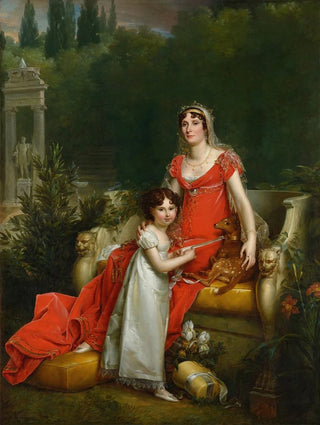Painting Élisa Bonaparte with her daughter Napoléona Baciocchi - François Gérard | Art print


View from behind

Frame (optional)
In the world of art, some works transcend their era to become privileged witnesses of a rich and complex history. The art print of Élisa Bonaparte with her daughter Napoléona Baciocchi by François Gérard is one of these iconic pieces, capturing not only the essence of a mother and her daughter but also the spirit of a time marked by political and social upheavals. François Gérard, court painter under Napoleon's reign, succeeded in immortalizing this family bond in a painting where tenderness blends with grandeur. Gazing upon this work, one is immediately transported to the heart of the early 19th century, a period when art was not only a reflection of reality but also a vehicle for propaganda and prestige.
Style and uniqueness of the work
The uniqueness of this piece lies in how Gérard manages to combine intimacy and majesty. Élisa Bonaparte, sister of Napoleon, is depicted with natural grace, draped in rich fabrics that evoke her aristocratic status. The delicate posture of the mother, tenderly holding her daughter, contrasts with the proud and determined gaze of Napoléona Baciocchi, who already seems to carry the family legacy. The colors chosen by Gérard, warm and soft, create an atmosphere conducive to introspection. The play of light and shadow accentuates the delicate features of the characters, while the blurred background helps focus attention on the central duo. This painting, far from being a simple representation, becomes a true scene of life, where every detail, from the knowing smile to exchanged glances, tells a story.
The artist and his influence
François Gérard, born in 1770, was an artist whose career was closely linked to the political events of his time. Trained at the Royal Academy of Painting and Sculpture, he quickly made a name for himself as a portraitist, attracting the attention of the imperial court. His style, marked by a romantic approach and mastery of colors, allowed him to stand out from his contemporaries. Gérard did not just settle for painting

Matte finish

View from behind

Frame (optional)
In the world of art, some works transcend their era to become privileged witnesses of a rich and complex history. The art print of Élisa Bonaparte with her daughter Napoléona Baciocchi by François Gérard is one of these iconic pieces, capturing not only the essence of a mother and her daughter but also the spirit of a time marked by political and social upheavals. François Gérard, court painter under Napoleon's reign, succeeded in immortalizing this family bond in a painting where tenderness blends with grandeur. Gazing upon this work, one is immediately transported to the heart of the early 19th century, a period when art was not only a reflection of reality but also a vehicle for propaganda and prestige.
Style and uniqueness of the work
The uniqueness of this piece lies in how Gérard manages to combine intimacy and majesty. Élisa Bonaparte, sister of Napoleon, is depicted with natural grace, draped in rich fabrics that evoke her aristocratic status. The delicate posture of the mother, tenderly holding her daughter, contrasts with the proud and determined gaze of Napoléona Baciocchi, who already seems to carry the family legacy. The colors chosen by Gérard, warm and soft, create an atmosphere conducive to introspection. The play of light and shadow accentuates the delicate features of the characters, while the blurred background helps focus attention on the central duo. This painting, far from being a simple representation, becomes a true scene of life, where every detail, from the knowing smile to exchanged glances, tells a story.
The artist and his influence
François Gérard, born in 1770, was an artist whose career was closely linked to the political events of his time. Trained at the Royal Academy of Painting and Sculpture, he quickly made a name for himself as a portraitist, attracting the attention of the imperial court. His style, marked by a romantic approach and mastery of colors, allowed him to stand out from his contemporaries. Gérard did not just settle for painting
12,34 €






